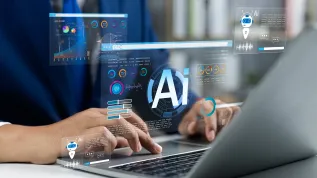
Most video materials are transferred today not between people, but between machines, says Polish inventor Dr. Marta Karczewicz. Her programs for compressing video materials, enabling, for example, streaming movies, serve people all over the world.
Every time you watch a film on a streaming service or smartphone, when you play computer games online or talk to someone using a video call in a messenger, you use solutions enabling the transmission of video data. The so-called codecs are responsible for it, and the vast majority of them are the work of Dr. Karczewicz, Vice President of Technology at Qualcomm.
Karczewicz comes from Szczecin. She has always been passionate about mathematics. After being among the top ten winners of the Polish Mathematical Olympiad (in the school year 1988/89), she initially studied at the then Szczecin University of Technology, and then accepted a grant from Nokia for signal and image processing research at the University of Tampere in Finland. There, she became interested in the issue of data compression. During her later work for Nokia, the Polish researcher developed key components of the AVC codec.
After several years of work at Nokia and completing her doctoral studies, Karczewicz moved to San Diego (USA), where in 2006 she started working for Qualcomm. There, she continued her work on codecs and contributed to the development of the latest video encoding standards, including High Efficiency Video Coding (HEVC) - the successor to AVC, enabling faster streaming on mobile devices.
In 2019, the Polish mathematician was nominated for the European Inventor Award, awarded by the European Patent Office (EPO) in the 'lifetime achievement' category. She was a member of the jury for this year's edition of the award, won by Dr. Olga Malinkiewicz.
PAP: What advice would you - the author of almost 700 patent applications and the owner of 130 European patents worth a total of one billion dollars - give to new inventors?
Marta Karczewicz: Be patient. You have to like solving problems and find your niche. You need perseverance to do your own thing, even when others think you will fail. When you focus on solving a problem, the invention will appear on its own.
PAP: Apparently you didn't believe it when you were nominated for the European Inventor Award in 2019?
M.K.: When I received the email with this information, I thought someone was pranking me. I started to check if it wasn't a scam. Before I decided that everything looked credible, I checked the sender and looked for information about the award granted by the EPO. I was also surprised that someone wanted to give me a European award despite the fact that I haven't lived in Europe for a long time, I lived in San Diego in the United States.
This nomination made me recognizable around the world, although I had already received a prestigious award from my current company, the 2012 Qualcomm Excellence Award. However, it was thanks to the interviews I gave after participating in the European competition that I was able to shed more light on my work. This included Poland, where several articles on video compression were published. This gave me great pleasure and satisfaction.
It was equally important for me to be able to draw attention to how few women there are still in technical fields and sciences. In every team that I managed so far, 90 percent of members were men. When I was still at school in Szczecin, I didn't feel any discrimination based on gender, and in my high school there were more or less equal numbers of boys and girls interested in science. But in the National Mathematical Olympiad (in the school year 1988/1989 - ed. PAP), I was the only girl in the top 10.
That's why I'm so happy about Olga Malinkiewicz's victory in this year's edition of the European Inventor Award. Besides, the EPO nominated more women this year. Something is finally changing, and the more we talk about women in science and engineering, the better.
PAP: You specialise in video materials.
M.K.: Yes. Nowadays, video is practically everywhere. Most videos are currently sent not between people, but between machines. There are cameras everywhere that constantly monitor the surroundings - the streets, workplaces, airports and industrial plants. The videos recorded by them are sent to the cloud, and artificial intelligence analyses these images. Based on them, it can send information about threats and accidents, about a product shortage in the warehouse or about problems on the production line in the factory. People do not even realize how much video material is recorded and then sent at any given moment.
PAP: Is that when your inventions come into play?
M.K.: Exactly. You cannot send raw video data. A video image is 24 to 120 frames per second, and in the currently popular Ultra HD or 4K resolutions, each frame is about 2,000 by 4,000 four pixels. Multiply the number of frames by the number of pixels and then by the number of bits per pixel to see that to send such a file without any compression, we would need about 30 gigabytes per second. There is no such internet yet. That is why we need data compression, i.e. a method of reducing information - frame by frame.
This is achieved with codecs - programs for converting a signal or data stream into an encoded form and for decoding them, e.g. on a smartphone or TV.
PAP: Are these new inventions?
M.K.: When I started my career in 1996 or 1997, when I was doing my PhD in Tampere, Finland, and working for Nokia, there was only one codec in use in the world. Since then, many others have appeared. I and the teams I led have many developed technologies that have been accepted in video compression standards and that have introduced significant changes to those standards.
The AVC standard, which I worked on while still at Nokia, is now a widely used codec. It is now fading away a bit, because it is being replaced by another one, AGVC, which I later developed for another company. Almost all electronics manufacturers use them, they are in almost every phone and TV. Another codec that we have recently created, VVC, will be coming to the market soon.
We are also creating annexes to existing codecs to adapt data compression to completely new solutions, such as VR goggles or Multi View Video. We are also working on technologies that enable better compression of images with many graphics - for example, when we present a slide show or share our monitor during a Teams call.
My company also manufactures chips for phones, so together with my team, I also deal with the implementation of algorithms in computer and electronic equipment. And the quality of compression also depends on the implementation of codecs.
PAP: What changes have these standards brought?
M.K.: We now need only about 15 percent of the network connection or device bandwidth that we had to provide to send mpeg 2 files. We can compress video from 100 to a 1,000 times. Without this, there would be no television, applications, games of today. In the past, people watched video in Standard Definition quality on small TVs, today they have 4K on huge screens.
PAP: Is the appetite for higher quality and faster data transfer still growing?
M.K.: It is a bit of a vicious circle. The demand is indeed still growing, because more and more video is being created and more bandwidth is needed. And in turn, sending such huge amounts of data would not be possible if there was no compression at the current level. Without it, for example, modern telemedicine would not exist.
Because it must be noted that video appears not only when we stream a TV series or play online. Yes, entertainment is important, but we also use video more often in other areas of everyday life and at work - during conference calls and conversations with loved ones, in industry, medicine. Video and data compression are more important than it seems at first glance.
I must admit that I it gives me a great pleasure to think that everything I worked on has hit the market and serves so many people in the world.
Interview by Anna Bugajska (PAP)
tr. RL













